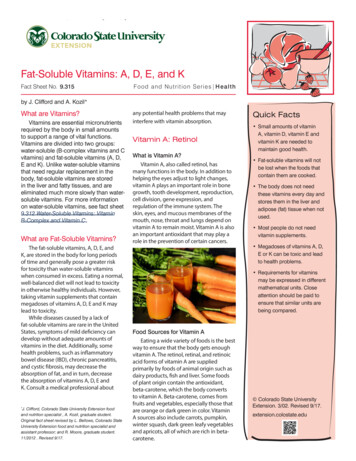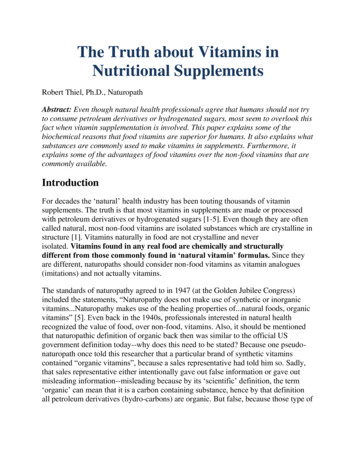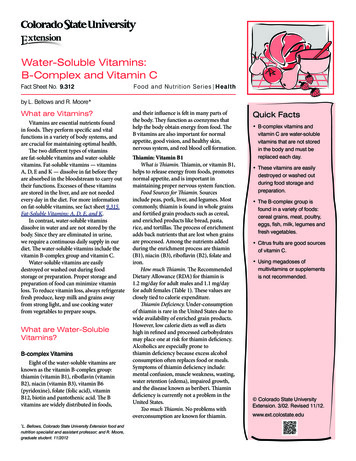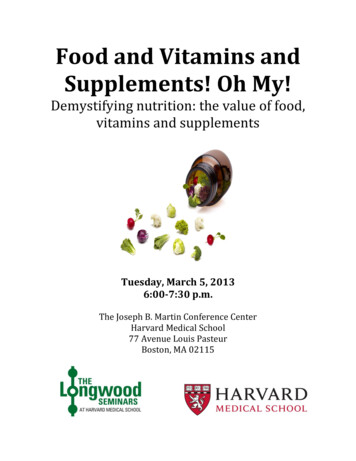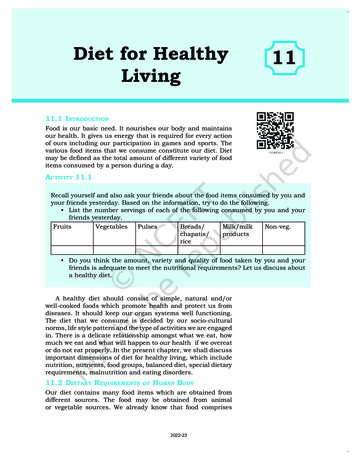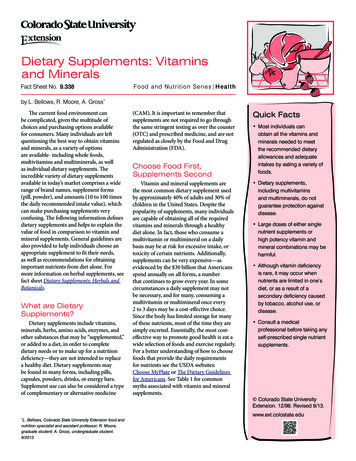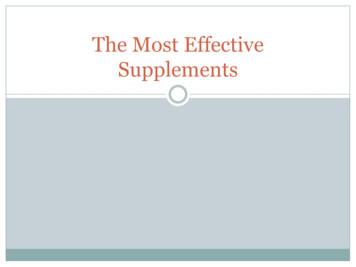
Transcription
Rick & Rosalinda Puetter—Personal vitamin/supplement use and practice, 6 February 2000.Vitamins, Supplements & Their UsesI. IntroductionOur interest in vitamins, dietary supplements, and nutritional biochemistry began in 1994. I in particular was a severe skeptic about supplements in general, and thought everything one’s body neededcould be supplied from a “healthy diet”. This, of course, is true to some degree. Healthy diets allow oneto live a long and pleasant life. This does not mean, however, that such a diet provides optimum nutrition. It was only through the persistent pestering of my wife, Rosalinda, that I finally agreed to try onesupplement: Chromium Picolinate. That was such an obvious success in providing increased energyand a feeling of well-being that I began to read extensively on the subject of nutritional biochemistry.If you become interested in this field, one recommendation that is of the greatest importance is toread, and to be very selective about your reading. There is a plethora of pseudo-scientific literature outthere under the topics of health and nutrition. This is one of the reasons the items listed below concentrate on non-herbal medicine. It is simply because there are more “western” scientific studies dealingwith vitamins and amino acids, etc., that have “hard science” behind them. This is not to say that herbalmedicine is without merit. It is simply to say that it is currently harder to find secure scientific facts aboutsuch topics. Let’s hope this changes in the future.The information given below is a distillation of some of the information I have found in over thirtybooks, a multitude of scientific papers, and the internet (especially medline). It was put togetherbecause a lot of people began asking me questions about dietary supplements and asked me to writedown a brief summary with some recent references (most of these facts could be supported with a list ofreferences that runs into the tens or more). The information is not exhaustive, and I am not a trained biochemist working in this field. It is, however, very interesting, and I think it is beginning to tell a storyabout the extreme importance of “mega”-nutrition to health and athletic performance (I can certainly provide my own anecdotal evidence for this). To provide information beyond what is presented below, I’veincluded a suggested reading list which contains a selection of books which I consider to be the bestexamples of approachable, popular scientific literature on the subject. These books are not afraid of providing lots of facts backed up by sometimes hundreds of references to the original scientific literature. Ihighly recommend them. They will help lead you through some of the details of nutrition and helpdebunk some of the widely held misconceptions of today (e.g. the gross misconceptions of what causeshigh blood serum cholesterol, the idea that the RDA vitamin levels are adequate, when and why saturated fast should be avoided, when and why poly-unsaturated fats should be avoided, etc.) Happy reading!Rick PuetterII. Supplements of Primary Importancea. Anti-Oxidants: Vit. A (or betacarotene), C, E, Selenium, Zinc, Manganese.Free radical damage is the leading theory of at least some forms of aging. Anti-oxidants intercept free radicals (chemicals with extra available electrons) before they damage (oxidize) the cell and its DNA.Vit. A (betacarotene pro-vit. A) and C: Water soluble vitamins. Betacarotene protects the skin from sunburn. Vit. C is an important co-factor in protein chemistry and has many other uses.Vit. E: Oil soluble vitamin. Acts as an anti-oxidant in fat cells, etc.Minerals: Act as agents in the formation of anti-oxidants. For example, selenium is the limiting mineral inglutathione per oxidase, one of the body’s primary anti-oxidants.Extra vitamin C is recommended, especially if you take Choline and/or Cysteine or are under emotional orphysical stress. We take a total of 4 gm of Vit C a day. Note: All vertebrates, with the exception of primates, make their own Vit. C. To have the average Vit. C concentration of the typical vertebrate, a 160pound person must consume roughly 10 gms of Vit. C per day. We use Trader Joe’s anti-oxidant capsules(2 pills morning. 2 pills evening), and Time release Vit. C (1 gm morning, afternoon, evening). TraderJoe’s supplement products are very good—compare them to others! Whoever is putting their formulationstogether, knows what he’s doing. They’re also extremely inexpensive.Page 1
Rick & Rosalinda Puetter—Personal vitamin/supplement use and practice, 6 February 2000.b. B Vitamins: B-1, B-2, B-3, B-5, B-6, B-12B Vitamins are the primary co-factors in almost all protein chemistry reactions (note that a lot of the B vitamins go by other names, e.g. B-3 Niacin—there are also a lot of B-Vitamin-like substances, e.g. GABA).So not to have them in abundant supply means that your body cannot efficiently produce the 50,000known proteins that occur in the human body. We use Trader Joe’s time release B-100 capsules (providing 100 mg of most almost all of the B vitamins—B12 in microgram amounts). Take one pill before bed.c. Minerals: More protein co-factors and anti-oxidant co-factors.Note: Men do not need any additional iron, especially in the iron fortified American diet. In fact, too muchiron in men has been shown to be bad for the heart. In general, minerals should not be taken with anti-oxidants since some constituents will cancel each other out (reactive minerals with oxidize the anti-oxidants).Be sure to use chelated or coloidal minerals. Elemental minerals are almost of no use (less than 10% bioavailable). Chelated minerals are roughly 50% bio-available. Coloidal minerals are almost 100% bioavailable but are very expensive. We use Trader Joe’s multi-minerals (chelated minerals). We recommend taking 2 to 4 pills in the afternoon.d. Cysteine: Sulfur containing amino acid .H3N The second amino acid in the sulfur containing amino acid chain( methionine cysteine taurine ). The sulfur containing aminoCCH2COOacids are extremely important. Sulfur-sulfur bonds are largely responsi- HSble for the catalytic shape of protein molecules and sulfur is what holdsproteins in cell membranes—see essential fatty acids below. CysteineHis normally the limiting amino acid in the formation of glutathione peroxidase, an important anti-oxidant, an antitoxin, an immune system stimuL-Cysteinelant1, a cancer preventative2, and a neuro-transmitter3. Note, takingglutathione peroxidase directly is expensive, and the body breaks it down before absorption anyway.Available at Henry’s. 500 mg in morning. 500 mg in afternoon. Good for hair and skin. Helps some men(10%) with baldness.e. L-Phenylalanine: Top of the Norepinephrine (nor-adrenaline) cyclePhenylalanine, “the Pain Reliever”, is one of the 8 essential amino acids.Phenylalanine is one of the aromatic amino acids (the others being tryosineand tryptophan). Phenylalanine gives energy, especially in the morning,enhances learning, alertness, and memory4,5. Source of important neurotransmitters. 500 mg per day in morning. Available at Henry’s. Note: Thissupplement should not be taken by phenylketonurics. DL-Phenylalanine isalso sometimes taken. For this amino (and a few others) the D form is nontoxic and of benefit. The D form is also used as a pain reliever.f. Chromium Picolinate: Helps with sugar metabolism. Antifat nutrient.H H N3CCOO-CH2PhenylalanineChromium is the limiting trace mineral in glucose tolerance factor (GTF), thesubstance that determines when the body will bring out more insulin to store blood sugar as fat. Picolinateis the form of niacin that is also used in GTF. Chromium in its trivalent form is well know to cut sugar cravings, increase the basal metabolism, and reduce caloric absorption6. We recommend 400 mcg per dayequivalent trivalent chromium: 200 mcg in the morning, 200 mcg in the afternoon. Note: Persons with1. Foster, LH; Sumar, S. “Selenium in health and disease: a review”, Critical Reviews in Food Science and Nutrition, 1997, 37(3):211-28.2. Smyth, JF; Bowman, A; Perren, T; Wilkinson, P; Prescott, RJ; Quinn, KJ; Tedeschi, M. “Glutathione reduces the toxicity andimproves quality of life of women diagnosed with ovarian cancer treated with cisplatin: results of a double-blind, randomised trial”,Annals of Oncology, 1997, 8(6):569-73.3. Braverman, ER, et al., “The Healing nutrients within”, (New Canaan, CN: Keats Publishing, 1997)4. Chiatow, L., “Amino acids in therapy”, (Rochester, VT: Healing Arts Press, 1988) 58-615. Braverman, ER, et al., “The Healing nutrients within”, (New Canaan, CN: Keats Publishing, 1997).6. Khan, A. et al. “Insulin potentiating factors and chromium content of selected foods and spices”, Biologic Trace Element Res 1990,24, 183-188.Page 2
Rick & Rosalinda Puetter—Personal vitamin/supplement use and practice, 6 February 2000.diabetes should consult a doctor before taking this supplement since it affects blood sugar chemistry.However, several studies have shown that chromium picolinate can slow down the onset of diabetes andin some cases reverse it.g. Broad-Spectrum Amino Acid Supplement.Several varieties are available: pills and powders. Get predigested proteins that have been broken downto free-form amino acids and di- and tri-peptide bonded amino acids. That’s why we’re taking the aminos,i.e. for easy absorption in case the body is having trouble breaking up our food protein or in producing specific amino acids in certain protein-protein chemical reactions. Also, several of the di- and tri-peptidebonded aminos are now suspected of being essential, i.e. needed and unable to be produced by the body.Amino acids are finding great use in general medicine in various dosages. Some of the uses are listed inTable 1, below.Table 1: Uses of Amino Acids in General MedicineaLower serum cholesterol and cineRelease growth hormone, propactin, ucineValineDimethylglycineHelp control TyrosineGlutamine & anGABAGlycineAlanineGABAHelp curb appetiteTryptophanProvide relief for ailing gall bladdersGlycineIsoleucineLeucineAmino AcidMethionineHelp control hypoglycemiaReduce blood pressureGABATaurineFight drug addictionHelp prevent insomniaBenefit liver patientsIsoleucineLeucineTryptophanRelieve chorea and tardive dyskinesiaPromote StaminaCarnitineMethionineControl Parkinson’s diseaseBuild muscle tissueAlanineCarnitineLeucineRelieve rnitineGABATryptophanCalm aggressivenessTryptophanGABATaurinea. Reprinted from “The Healing Nutrients Within”. For details of the use and dosages of the amino acidslisted above, see the suggested reading.Page 3
Rick & Rosalinda Puetter—Personal vitamin/supplement use and practice, 6 February 2000. H3NCHHHCOO-CH2OHCOO- H N3CCOO- H N3CCHH3N CH2CH2CH2CH2CH2CH2CH2CH2CONH2NHCNH2 COO-NH3 NH2TyrosineGlutamineArginineOrnithineIII. Supplements of “Secondary” (?) Importanceh. L-Tyrosine: Amino acid. Neuro-transmitter precursor.Tyrosine, “The Antidepressant”, is the second step in Norepinephrine cycle. A precursor to importantneuro-transmitters and a general stimulant and strengthener of the thyroid. It is a minor growth hormonestimulant and may aid in the correction of mild hypothyroidism1. We take 500 mg in the morning. Available at Henry’s.i. L-Glutamine: amino that helps clean out the ammonia from the brain.Helps with jet lag, memory, and concentration. Studies have shown that students have improved testscores if they take glutamine before exams. Available at Henry’s. We recommend 500 mg in the afternoon.j. L-Arginine & L-Ornithine: Amino acids from the Urea cycle. Anti-fat nutrients.These amino acids stimulate the release of growth hormone (GH). This in turn stimulates the immune system and helps the body repair itself. They make the body build protein and burn fat like a teenager, etc.Available at Henry’s. We recommend 5 gm (or more) per day before bed. This is the level found to provide good muscle growth in 50% of the population. Arginine has been tested at 20 gm doses for over 25years without any harmful effects!. The natural time for release of GH is 1 hour after sleep starts and during and right after exercise. This supplement is normally mixed in a 2 to 1 Arginine to Ornithine ratio. (Ornithine is twice as effective as Arginine in producing GH.) This was the supplement that had the biggestnoticeable effect on my body (RIck), dramatically changing muscle tone and producing significant fat losswithout changing exercise program or eating habits. For other friends, these supplements had no affect.However, the form discussed below helped even these friends.The alpha-ketogutarate form of L-ornithine is a popular body building aid. The gutarate molecular skeleton(same chemical skeleton as glutamine—see above) helps the ornithine cross the blood-brain barrier foreasier absorption. (Remember Glutamine/Glutamic acid is the primary vehicle for removing ammonia fromthe brain. That’s why it crosses the blood-brain barrier so easily.) This supplement can be obtained atHenry’s. Twin-Labs GH-Fuel, OKG. Also from Bricker Labs.1. Chiatow, L., “Amino acids in therapy”, (Rochester, VT: Healing Arts Press, 1988) 58-61.Page 4
Rick & Rosalinda Puetter—Personal vitamin/supplement use and practice, 6 February 2000.k. Choline & Inositol: Amino acids. Anti-fat nutrients.These supplements aid in fat metabolism. Both are liver stimulants. We take these (along with some chromium Picolinate, L-carnitine, methionine, and a few other substances) in a formulation called “Fat Burners”. There are several Fat Burner formulations on the market. All are pretty similar. Buy the cheapest.You can get this at Henry’s. The Fat Burners come in 500 mg pills. Take 4 pills per day (or more—we take6) in divided doses.Choline and inositol are also important components of phosphatides, the chemicals that make up everycell membrane in the body. Choline is also the precursor to the important memory neuro-transmitteracetyl-choline. Memory improvement (especially short term memory) is common with choline supplements. Personally, I’ve noticed a large improvement in my memory since taking this supplement.l. L-Carnitine: Amino acid. Anti-fat nutrient.This amino acid helps with fat metabolism. It is important in the transport of free form triglycerides (fats)across mitrocondrial membranes in brown adipose tissue. We recommend 500 to 1000 mg per day individed doses, 1 hour before meals.m. Flax Seed Oil: Essential Fatty acids (EFAs).Most of the oils available in the supermarket are heat damaged, non-natural (heat processing has changedthem), mildly toxic, trans-fatty acids (i.e. a chemically more stable form of the cis-fatty acids essential tolife’s biochemistry). The omega-3 and omega-6 (first double carbon-carbon bond between the 3rd and 4thor between the 6th and 7th carbons respectively) are essential to human life since we do not have theenzymes necessary to make these bonds—we do have the enzymes necessary to make the other important double bonds, e.g. between 9 and 10 (as in olive oil), and between 12 and 13, and between 15 and 16,etc. Without omega-3 fats, you get very sick. Without omega-6, you can die. These fats are precursors tomany hormones and prostaglandins (eicosanoids)—see Fish Oils, below.EFAs are essential for healthy cell membranes (increase cell membrane fluidity and cell metabolism—theelectrically charged, curved, cis-fatty acids hold protein enzymes in the cell membranes through sulfurbonds—see Figure 1). They also reduce fatty build-up in the arteries—yes, these fats actually remove fat!.Take 1 to 2 gm per day. Excellent tasting oil for salad dressing if you want to avoid pills, but it spoils easilyunless kept in the dark and in the refrigerator. Available at Henry’s.There’s Lots of linolenic (cis-18:3w3) and other good fats in Flax Seed Oil!cis-18:3w3unpaired H’s all on same side make a “cis” fatty-acidH H H H H H H H H H H H H H H H HFattyend H C C C C C CH Hdouble bondon 3rd carbonmakes an w3 acidH HOAcidC C C C C C C C C C C CendO HH HH H H H H H H Hcis-nature of molecule causes curvature.Concave and negative, this side.alpha linolenic acid, a Flax seed omega-3 fatty acid with 18 carbonsand 3 double bonded carbonsPage 5
Rick & Rosalinda Puetter—Personal vitamin/supplement use and practice, 6 February 2000.n. Evening Primrose Oil: Gamma linolenic acid. Anti-Fat Nutrient.This fat stimulates fat burning. Evening Primrose oil is also a source of essential fatty acids. It also helpswomen with menstrual problems. 1 to 2 gm per day. Get at Trader Joe’so. Fish Oils: Highly unsaturated fats from cold water fish.Fish oils from cold water fish provide some of the most highly unsaturated natural fats around—cold waterfish require highly unsaturated fats so that they remain liquid at the cold temperatures of the water they livein. These fats help clear out the arteries by replacing the more solid saturated fats. They are especiallyuseful in promoting the “good” eicosanoid (prostaglandin) families. (Eicosanoid are hormone-like substances containing 20 carbon atoms. They arise from the essential fatty acid oils we consume.) The E2family of eicosanoids are now thought by many to be responsible for a variety modern health problems.(Stay away from sugar and don’t over-eating carbohydrates as this stimulates lots of insulin and promotesthe E2 family—see Eades and Eades and/or Eramus in the suggested reading.) The E1 family (and E3family), on the other hand, are thought to aid substantially with health (see Table 2).Linoleic acid (cis-18:2w6) is the normal starting point for the formation of the eicosanoids. Conversion oflinoleic acid (LA) to the E1 eicosanoid family is blocked by trans-fatty acids (watch out for these, they’reeverywhere these days, especially in margarine), alpha linolenic acid (ALA), and a high carbohydrate diet.Note that there is a lot of ALA in flax seed oil. So what’s going on here? Is flax seed oil good for you ornot? Well, there’s currently a lot of argument over this. It blocks E1 formation, but is normally necessaryfor E3 eicosanoid formation (it’s at the top of the E3 family tree). However, flax seed oil seems to be goodfor lots of things, and many researchers feel that it is the total balance between the omega-3 fatty acid ALAand the omega-6 fatty acid LA that is important. However, if you’re concerned, fish oils rich in eicosapenremove this fatty acidand replace with phosphate to make phosphotidetrappedproteinCell membraneTriglycerideEssentialfatty aciddouble wall layer of phophotidesFigure 1 Triglycerides,Phosphotides, and cellmembranes. Phosphotides, derived by replacing a fatty acid on one ofthe glycerine oxygenatoms with a phosphategroup, are the functionalunits in the make-up ofevery cell membrane inthe body. EFAs have atendency to occupy thecentral oxygen atom ofthe glycerine moleculeand hold sulfur containing proteins in the cellwalls. All cell metabolism is performed bythese trapped proteins.Page 6
Rick & Rosalinda Puetter—Personal vitamin/supplement use and practice, 6 February 2000.taenoic acid (EPA, 20:5w3) might be a nice supplement to LA rich oils. EPA helps to deactivate delta 5desaturase1, the step required to form arachidonic acid, which is at the top of the E2 eicosanoid chain anddirectly feeds the E3 eicosanoids.Table 2: Effects of E1 and E2 Eicosanoid FamiliesE1, the “Good” EicosanoidsE2, the “Bad” Eicosanoidsact as vasodilatorsact as vasoconstrictorsact as immune system enhancersact as immune system suppressorsdecreases inflammationincreases inflammationdecreases painincreases painincreases oxygen flowdecreases oxygen flowincreases endurancedecreases enduranceprevents platelet aggregationcauses platelet aggregationdialates airwaysconstricts airwaysdecreases cellular proliferationincreases cellular proliferationp. DMAE (Di-methyl amino ethanol): Smart drug.This is a very effective, over-the-counter smart drug that can improve your memory—it has improved mine!It is naturally occurring in fish, i.e. “brain food”. DMAE elevates mood, improves memory and learning,increases intelligence, and has been found to extend the life span of laboratory animals. Riker Laboratories has developed a prescription drug (Deaner or Deanol) which is a p-acetamidobenzoate salt of DMAEand which has very similar effects. Riker markets this drug for the treatment of learning problems, underachievement, shortened attention span, hyperactivity, reading and speech difficulties, impaired motorcoordination, and behavior problems in children. DMAE works by accelerating the brain’s synthesis of theneuro-transmitter acetylcholine, which plays a key role in maximizing mental ability as well as preventingloss of memory in aging adults. Available at Henry’s.q. Melatonin: Anti-oxidant, sleep promoter, immune system stimulantMelatonin is the most powerful hydroxyl radical scavenger known2. It is an ancient, simple, hormone-likesubstance that many think was the precursor to gutathione peroxidase early in the evolution of lifeforms. Ithas also been linked to strengthening of the immune system and for help to prevent premature aging3,4,5.Taking it for these benefits is probably the best reason for taking melatonin, but many take it for its sleeppromoting properties. It is also a precursor to seratonin, the sleep hormone. It is useful for jet-lag andresets the body’s internal clock. It is produced by the pineal gland. Teenagers produce roughly 12 mg/dayof the stuff. Production of melatonin falls off rapidly after the age of 20. Standard pill does are 3 mg/pill.We take 1 pill in the evening before bed. I’ve also found an extra pill (or two) helpful in getting to sleep ona restless night. Some people find it makes them groggy in the morning. Usually this passes as the bodybecomes accustomed to the supplement. Available at Henry’s.r. DHEA: Hormone precursor, anti-cancer agent, anti-fat nutrientThis is a true wonder supplement. It is a simple hormone precursor that has almost 100% absorption inthe body by oral administration. This was just recently allowed by the FDA to be sold over the counter. Inwomen it is a precursor to estrogen, in men to testosterone (although high doses does produce facial hairin women—doses in excess of 100 mg/day). A number of studies have demonstrated that this is an effective anti-cancer agent. It is also well demonstrated as a weight loss agent—it returns the body to its youth1. “EPA is the most important factor limiting PG2 (eicosanoid family 2) production.” from Fats that Heal, Fats that Kill, Eramus—see suggested reading.2. Reiter RJ; Tan DX; Poeggeler B; Menendez-Pelaez A; Chen LD; Saarela S, “Melatonin as a free radical scavenger: implications foraging and age-related diseases”, Ann N Y Acad Sci 1994; 719: 1-123. Maestroni GJ, “The immunoneuroendocrine role of melatonin”, J Pineal Res 1993; 14(1): 1-10.4. Pierpaoli W; Lesnikov VA, “The pineal aging clock. Evidence, models, mechanisms, interventions”, Ann N Y Acad Sci 1994: 31;719:461-73.5. Poon AM; Liu ZM; Pang CS; Brown GM; Pang SF, “Evidence for a direct action of melatonin on the immune system”, Biol Signals1994; 3(2): 107-17Page 7
Rick & Rosalinda Puetter—Personal vitamin/supplement use and practice, 6 February 2000.Linoleic acid(18:2w6)Gamma Linoleicacid (18:3w6)Dihomogammalinoleic acid(20:3w6)GoodGuysArachidonicacid (20:4w6)Adrenic acid(22:4w6)Docosapentaenoic acid(22:5w6)EicosanoidFamily E2BadGuysEicosanoid(Prostaglandin)Family E1Linoleic acid(18:2w6)Stearidonicacid (18:4w3)Eicosatetraenoic acid(20:4w3)Eicosapentaenoic c acid(22:6w3)GoodGuysEicosanoidFamily E3Figure 2 Manufacture of Eicosanoids (prostaglandins) in the body from essential fatty acids.ful ways. Animal studies of this substance are extensive and astounding. It seems good for almosteverything. Human studies are just seriously beginning. Results of these studies are often contradictory(small numbers of persons are often used in the study and controlling the subjects is harder than formice!). Nonetheless, my reading of the literature seems to show the majority of studies show DHEA beneficial for most things, including cancer of all types1,2,3, immune system stimulation4,5, increased energy6,more rapid muscle growth, mood enhancement7, improved mental function8,9,10, and weight loss11.Page 8
Rick & Rosalinda Puetter—Personal vitamin/supplement use and practice, 6 February 2000.s.HMB ( β -hydroxyβ -methylbutarate): Protein break-downsuppressorOkay body-building enthusiasts! The nexttwo supplements are what you’ve beenwaiting for. I’ve tried them and they’redynamite. First, HMB.It has been known for a long time that thebranched chain amino acids, leucine, isoleucine, and valine—see chart, areextremely beneficial in promoting musclegrowth and recovery from hard exercise.Leucine, in particular, was found to beespecially good. Recently a group at theUniversity of Iowa has discovered that thebenefits of the branch chained aminos isprobably due to a specific metabolite ofleucine, β -hydroxy β -methyl butarate.This specific metabolite has been patented by the University of Iowa and is nowbeing sold by several supplement companies. Clinical tests have shown that thissupplement grows muscles 300% fasterthan without such supplementation. Thisis as good (or better) than the resultsachieved with anabolic steroids.AndHMB doesn’t have any of the negativehealth problems of steroid, e.g. liver damage, heart problems, high blood pressure.I’ve used branched chain amino fortifiedprotein drinks before. These halved myrecovery time in the gym, from two days to one day. HMB is MUCH better. Recovery time is now about 1/2 day and there is practically no soreness even after extremely hard workouts. And the muscle growth istremendous.1. Luo S, Labrie C, Belanger A, Labrie F, “Effect of dehydroepiandrosterone on bone mass, serum lipids, and dimethylbenz(a)anthracene-induced mammary carcinoma in the rat”, Endocrinology 1997, 138(8): 3387-3394.2. Perkins SN, Hursting SD, Haines DC, James SJ, Miller BJ, Phang JM, “Chemoprevention of spontaneous tumorigenesis in nullizygous p53-deficient mice by dehydroepiandrosterone and its analog 16alpha-fluoro-5-androsten-17-one”, Carcinogenesis 1997;18(5): 989-994.3. Kohama T, Terada S, Suzuki N, Inoue M, “Effects of dehydroepiandrosterone and other sex steroid hormones on mammary carcinogenesis by direct injection of 7,12-dimethylbenz(a) anthracene (DMBA) in hyperprolactinemic female rats”, Breast Cancer ResTreat 1997; 43(2): 105-115 .4. Suitters AJ, Shaw S, Wales MR, Porter JP, Leonard J, Woodger R, Brand H, Bodmer M, Foulkes R,“Immune enhancing effects ofdehydroepiandrosterone and dehydroepiandrosterone sulphate and the role of steroid sulphatase”, Immunology 1997; 91(2): 314321.5. Shealy CN,“A review of dehydroepiandrosterone (DHEA)”, Integr Physiol Behav Sci 1995; 30(4): 308-313.6. Watson RR, Huls A, Araghinikuam M, Chung S, “Dehydroepiandrosterone and diseases of aging”, Drugs Aging 1996; 9(4): 274291.7. Prasad A, Imamura M, Prasad C, “Dehydroepiandrosterone decreases behavioral despair in high- but not low-anxiety rats”, PhysiolBehav 1997 62(5): 1053-1057.8. Rupprecht R, “The neuropsychopharmacological potential of neuroactive steroids”, J Psychiatr Res 1997; 31(3): 297-314 .9. Friess E, Trachsel L, Guldner J, Schier T, Steiger A, Holsboer F, “DHEA administration increases rapid eye movement sleep andEEG power in the sigma frequency range”, Am J Physiol 1995; 268(1 Pt 1): E107-E113.10. Flood JF, Morley JE, Roberts E, “Memory-enhancing effects in male mice of pregnenolone and steroids metabolically derived fromit”, Proc Natl Acad Sci U S A 1992; 89(5): 1567-1571.11. Hansen PA, Han DH, Nolte LA, Chen M, Holloszy JO, “DHEA protects against visceral obesity and muscle insulin resistance inrats fed a high-fat diet”, Am J Physiol 1997; 273 (5 Pt 2): R1704-R1708Page 9
Rick & Rosalinda Puetter—Personal vitamin/supplement use and practice, 6 February 2000.t. Creatine Phosphate:growthMuscleThe Branched chain amino acidsCreatine monohydrate has long been asolid weight training supplement. Creatineis a precursor of ATP, the source of cellular energy. Muscle cells have a hugecapacity to absorb creatine and thus havea ready reserve for ATP production. Mostclinical studies have been done with creatine monohydrate. They have clearly demonstrated the great increase in muscleenergy and reduction in muscle fatigue.This allows for deeper working of the muscle in the gym, which probably accounts for part of the enhancedmuscle growth. In addition, however, creatine helps the muscle to saturate with water. It is thought thatthis improves the conditions for muscle growth. In any event, I’ve found creatine to be exceptionally good.I feel strong when I take it and can work much harder at the gym. Even after hard sets, recovery is veryrapid and I can perform repeat sets. I’m using creating phosphate rather than the monohydrate form—which seems to be the new rage in the industry. This makes sense since the creatine must join with phosphate to form ATP.u. Methylation, Folic Acid (Folate), B-12, Trimethylglycine, & S-AdenosylmethionineRecent research indicates that the physiological process known as methylation is directly related to manydiseases, including cancer, heart disease, liver disease, osteoarthritis, and neurological disorders (e.g.Alzheimer's disease). Furthermore, methylation also appears to play a significant role in the aging processin general and is how the action of DNA is made specific to the cells in given locations in the body (i.e. howliver cells know to become liver cells even though they have all the genetic
Vitamins, Supplements & Their Uses I. Introduction Our interest in vitamins, dietary supplements, and nutritional biochemistry began in 1994. I in par-ticular was a severe skeptic about supplements in general, and thought everything one's body needed could be supplied from a "healthy diet". This, of course, is true to some degree.
